Something remarkable happened this summer.
The Business Roundtable’s “Statement on the Purpose of a Corporation,” called for companies to expand their concerns beyond shareholders and the bottom line to consider how they can also benefit customers, employees, suppliers, and communities. It drew a great deal of praise from those of us working in development. I read it though, not only as a greater commitment to corporate social responsibility, but also as an expression of need. When profits alone are no longer the measure of success, what other metrics will the private sector use to demonstrate their impact on well-being, or income, or the environment?
Nearly four years ago, the U.N. presented the Sustainable Development Goals (SDGs), also known as the Global Goals to end poverty, protect the planet, and create a just and sustainable future by 2030. This call to action has been galvanizing, and governments, nonprofits, and the private sector have all begun to define themselves against these 17 Goals, identifying one or a few that intersect with their work, and declaring their commitment to help achieve them. But again, how can they reliably measure those contributions, and home in on the area where they might have the greatest impact?
My colleagues and I at SDG Impact, are working on these very questions, and we are just beginning to tell the world about them. We are developing globally agreed standards for various asset classes that will quantify, focus, and enhance their contributions toward the SDGs. These standards will help investors and companies go beyond using the goals to map existing activities, to a more integrated practice of directing and orienting investment into activities that create more impact and contribute to measurable progress. The first set, for private equity investors, is now available for public comment and consultation.
Making informed decisions
The standards help investors make informed decisions using impact measurement and management; they also speak to the ‘tone at the top,’ assessing the commitment of a fund’s board and senior management to integrity and sound management. Other standards, for bonds and for enterprises, are forthcoming. Investors and companies that adhere to these standards will be eligible for an SDG Impact Seal, making it clear to all that their commitment to the SDGs and their impact are measurable.
We are setting up a system of online education and training and designing a certification programme for independent evaluators who will determine applicants’ eligibility for the SDG Impact Seal. We are receiving feedback until December 4, 2019, so that those who will be using these standards can help us make them as useful as possible.
We are also preparing SDG Investor Opportunity Maps, an online market intelligence tool that provides localized data and specific information on investment and business opportunities that align with the SDGs. Users can apply various filters to narrow in on regions, sectors, political context, social and environmental challenges, and identify areas where their work can have significant impact. Our first map covers Brazil, which unearthed 21 investment opportunities in six sectors, and we will be producing these maps globally over the coming year.
As an example of how the Investor Opportunity Maps works, in light of the wildfires that have raged through the Amazon rainforest in recent weeks, one could imagine an SDG-minded fund manager seeking projects that protect the environment in Brazil. Our online tool could inform this manager that mixed plantation forestry for commercial timber production is a US$35 billion industry, that the Brazilian Development Bank is supporting loans to investors in reforestation and sustainable forestry businesses, and that such investments would contribute toward SDG 15: “Protect, restore and promote sustainable use of terrestrial ecosystems, sustainably manage forests, combat desertification, and halt and reverse land degradation and halt biodiversity loss.” The Brazil map and many others will also soon be available for public use.
Impact investing
The SDGs have taken off in the hearts and minds of many, yet only a fraction of the globally invested assets of funds, banks, pensions, and multinational companies are in SDG sectors. This may be a numbers issue. Until now, there has been virtually no reliable, consistent set of figures quantifying impact investing. Instead, outdated and often inaccurate assumptions about opportunity and risk have steered a lot of capital away from the developing world. In 2017, only two percent of global foreign direct investment flows, US$26 billion, went to the world’s 47 least developed countries with a combined population of some one billion people. If we are to achieve the Global Goals by 2030, we need much more action. We believe that mobilizing an additional five percent of global assets under management yearly (about US$6 trillion) is a realistic goal.
As the Business Roundtable statement indicates, we are at the beginning of what has the potential to be a remarkable change. ‘Business as usual’ is literally no longer tenable, and certainly not congruent with a sustainable future.
We at SDG Impact are confident that with the right information, the Global Goals are within reach.

 Locations
Locations

